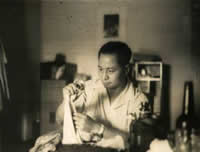History
British newsreels
 Newsreels were a regular feature of British cinema programmes between 1910 and 1979. For the first twenty years of their existence they were silent, with titles to introduce and describe each item, and accompanied by live music. They were usually issued twice-weekly. The leading British newsreels of the silent period were Pathe Gazette, Gaumont Graphic and Topical Budget. The first British sound newsreel, British Movietone News, appeared in June 1929. By the mid-1930s the familiar newsreel style became established, with authoritative commentator and upbeat musical accompaniment. The prominent reels were Movietone, Pathe Gazette (later Pathe News), Gaumont-British News, British Paramount News and Universal News. These were a familiar part of the cinema programme until the mid-1950s, when the emergence of daily television news began to render them obsolete. Most had folded by the end of the decade, but Pathe continued to 1970, and Movietone only closed in 1979. Today their film libraries live on, used in television programmes and increasingly available online.
Newsreels were a regular feature of British cinema programmes between 1910 and 1979. For the first twenty years of their existence they were silent, with titles to introduce and describe each item, and accompanied by live music. They were usually issued twice-weekly. The leading British newsreels of the silent period were Pathe Gazette, Gaumont Graphic and Topical Budget. The first British sound newsreel, British Movietone News, appeared in June 1929. By the mid-1930s the familiar newsreel style became established, with authoritative commentator and upbeat musical accompaniment. The prominent reels were Movietone, Pathe Gazette (later Pathe News), Gaumont-British News, British Paramount News and Universal News. These were a familiar part of the cinema programme until the mid-1950s, when the emergence of daily television news began to render them obsolete. Most had folded by the end of the decade, but Pathe continued to 1970, and Movietone only closed in 1979. Today their film libraries live on, used in television programmes and increasingly available online.
Download a more detailed history of newsreels (PDF)
British cinemagazines
The cinemagazine was a periodically-released film series shown in cinemas (and on television), in Britain and the Commonwealth, over the period 1910s-1980s. It was closely allied to the newsreel, and some cinemagazines were produced by newsreel companies, but the form ranged widely. Some had a news or documentary function (This Modern Age), some were entertainment supplements to newsreels (Gaumont Mirror), some were sponsored by industrial concerns (Oil Review), some were issued by government bodies for national (Britain Can Make It) or international (This Week in Britain) consumption. Cinemagazine is the common term for the genre, but they were also known as screen magazines or magazine films. Leading British producers of cinemagazines included Pathe, Rank, the National Coal Board, and particularly the Central Office of Information, which used the cinemagazine form in distributing films and programmes overseas that promoted the British way of life in the 1950s and 1960s. The cinemagazine began as part of the cinema programme, but its form lent itself naturally to television, and its legacy is the ubiquitous television magazine programme.
Download a more detailed history of newsreels (PDF)
 Learning on Screen
Learning on Screen